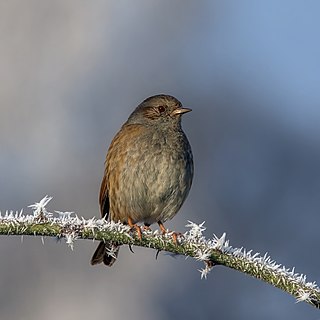
The accentors are a genus of birds in the family Prunellidae, which is endemic to the Old World. This small group of closely related passerines are all in the genus Prunella. All but the dunnock and the Japanese accentor are inhabitants of the mountainous regions of Europe and Asia; these two also occur in lowland areas, as does the Siberian accentor in the far north of Siberia. These birds are not strongly migratory, but they will leave the coldest parts of their range in winter and make altitudinal movements.
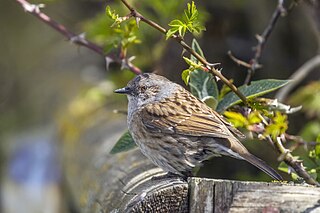
The dunnock is a small passerine, or perching bird, found throughout temperate Europe and into Asian Russia. Dunnocks have also been successfully introduced into New Zealand. It is by far the most widespread member of the accentor family; most other accentors are limited to mountain habitats. Other common names of the dunnock include: hedge accentor, hedge sparrow, hedge warbler, and titling.

The alpine accentor is a small passerine bird in the family Prunellidae, which is native to Eurasia and North Africa.

The black-throated accentor is a small passerine bird found in the Ural, Tian Shan and Altai Mountains. It is migratory, wintering in Afghanistan and neighboring countries. It is a rare vagrant in western Europe.

The laughing falcon is a medium-sized bird of prey in subfamily Herpetotherinae of family Falconidae, the falcons and caracaras. It is found from Mexico south through Central America and in every mainland South American country except Chile and Uruguay.

The Andean tinamou is a tinamou, found commonly in high-altitude shrubland, in the Andes of South America.

Oligoryzomys fulvescens, also known as the fulvous colilargo, fulvous pygmy rice rat, or northern pygmy rice rat, is a species of rodent in the genus Oligoryzomys of family Cricetidae. It is found from southern Mexico through Central America into South America, where it occurs south into Peru and Brazil, and includes numerous synonyms, including the type species of the genus, Oryzomys navus Bangs, 1899. The taxonomy of this species is unresolved, and it may be found to contain more than one species. Its karyotype has 2n = 54-60 and FNa = 68–74.

The Siberian accentor is a small passerine bird that breeds in northern Russia from the Ural Mountains eastwards across Siberia. It is migratory, wintering in Korea and eastern China, with rare occurrences in western Europe and northwestern North America. Its typical breeding habitat is subarctic deciduous forests and open coniferous woodland, often close to water, although it also occurs in mountains and spruce taiga. It inhabits bushes and shrubs in winter, frequently near streams, but may also be found in dry grassland and woods.
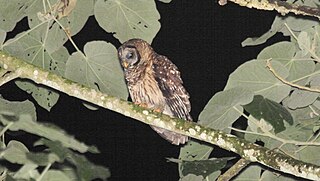
The fulvous owl, or Guatemala barred owl, is a resident of the cloud forests of Central America. A medium-sized true owl, it has a round head, lacking ear tufts. Its typical coloration is warm dark brown or reddish brown on the back and lighter brown on the front with darker barring. Adults weigh approximately 600 grams (21 oz), with females being heavier. Its distribution is limited to highland regions of Guatemala, Honduras, and El Salvador. It inhabits elevations from 1,200 to 3,100 meters, and is fairly common within its range. Its behavior is poorly known, as are its population size and distribution. It is classified as a species of least concern by the International Union for Conservation of Nature, although it is considered endangered in Mexico.

The brown illadopsis or brown thrush-babbler, is a species of bird in the family Pellorneidae. The species was first described by John Cassin in 1859. It is widely spread throughout the African tropical rainforest. Its natural habitats are subtropical or tropical dry forests and subtropical or tropical moist lowland forests.
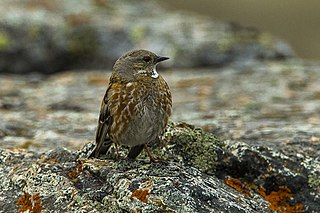
The Altai accentor is a species of bird in the family Prunellidae. It is also known as the rufous-streaked accentor or Himalayan accentor. It breeds in the Altai Mountains of western Mongolia; it winters in the southern Tian Shan and Himalayan ranges.
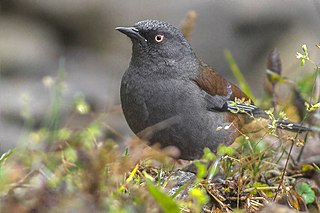
The maroon-backed accentor is a species of bird in the family Prunellidae. It is found in Bhutan, China, India, Myanmar, and Nepal.

Kozlov's accentor or the Mongolian accentor, is a species of bird in the family Prunellidae. It is found in Mongolia and northern China.

Radde's accentor is a species of bird in the family Prunellidae. It is found in mountainous parts of Yemen and northern Southwest Asia.

The robin accentor is a species of bird in the family Prunellidae. It is found in the mountainous regions of Afghanistan, Pakistan, India, Nepal, Bhutan and China, at altitudes between about 3,000 and 5,500 m. It is a brown bird with a grey head and an orange-red breast. It is common in parts of its range and its conservation status has been assessed by the International Union for Conservation of Nature as being of "least concern".
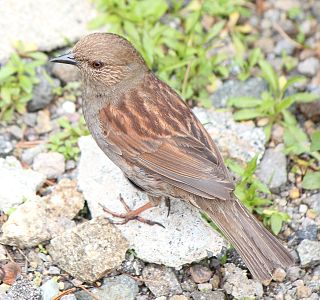
The Japanese accentor is a species of bird in the family Prunellidae. It is found in Japan and Sakhalin.

The rufous-breasted accentor is passerine bird in the family Prunellidae, endemic to the Himalayas, descending in the winter to lower-to-middle altitudes. It is found in Afghanistan, Bhutan, Tibet, China, India, Myanmar, Nepal, and Pakistan.

The burnished-buff tanager, also known as the rufous-crowned tanager, is a common South American species of bird in the family Thraupidae.

The ochraceous piculet is a species of bird in subfamily Picumninae of the woodpecker family Picidae. It is endemic to eastern Brazil.

The Oriental Basin pocket gopher is a species of pocket gopher which is endemic to Mexico. It was first described in 1895 by Clinton Hart Merriam. It was considered to be a subspecies of Merriam's pocket gopher in the late 20th and early 21st century but has been reinstated as its own species. The IUCN Red List has evaluated it to be of least concern.





















